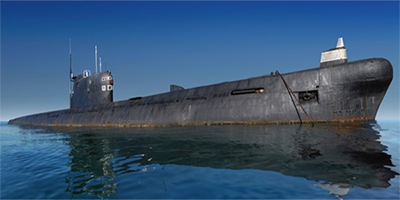Thinner Stealth Coatings
To avoid detection by sonar, submarines are often covered with sound-absorbing, perforated rubber tiles called anechoic coatings. The tiles in use today are a few centimeters thick, but the same degree of stealth protection could perhaps be provided by a much thinner coating, according to researchers in Canada and France. They predicted that a few millimeters of soft material containing regularly spaced air pockets can absorb well over 99% of the acoustic-wave energy impinging on it.
Researchers have known for some time that embedding a thin elastic layer with cylindrical, air-filled cavities makes an excellent sound absorber, but figuring out how to optimize such materials for a particular frequency or application has involved time-consuming numerical simulations. To simplify the problem, Valentin Leroy at Paris-Diderot University, France, and his colleagues modeled the cavities as spherical bubbles, each with a springy response to a pressure wave and a resonant frequency that depends on its size and the elasticity of the surrounding material. The simplification allowed them to derive an analytical equation that relates sound attenuation at a given frequency to the material properties and cavity size and spacing.
Leroy and his colleagues found good agreement between the equation’s predictions and underwater tests bouncing megahertz waves off a 230-micrometer-thick polymer filled with air cavities and deposited on a steel slab. They have not yet tested the perforated polymers at sonar frequencies, but according to their calculations, 4-millimeter films with 2-millimeter-sized bubbles could attenuate reflected waves by more than 10,000-fold—about a hundred times better than what was previously assumed possible.
This research is published as a Rapid Communication in Physical Review B.
–Jessica Thomas





